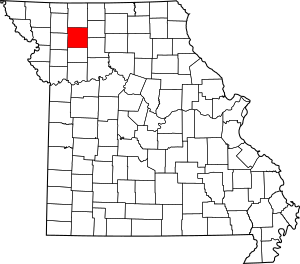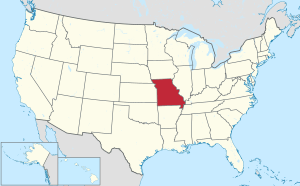Daviess County, Missouri facts for kids
Quick facts for kids
Daviess County
|
|
|---|---|

Daviess County Courthouse in Gallatin
|
|

Location within the U.S. state of Missouri
|
|
 Missouri's location within the U.S. |
|
| Country | |
| State | |
| Founded | December 29, 1836 |
| Named for | Major Joseph Hamilton Daviess |
| Seat | Gallatin |
| Largest city | Gallatin |
| Area | |
| • Total | 569 sq mi (1,470 km2) |
| • Land | 563 sq mi (1,460 km2) |
| • Water | 5.8 sq mi (15 km2) 1.0% |
| Population
(2020)
|
|
| • Total | 8,430 |
| • Estimate
(2021)
|
8,399 |
| • Density | 14.815/sq mi (5.720/km2) |
| Time zone | UTC−6 (Central) |
| • Summer (DST) | UTC−5 (CDT) |
| Congressional district | 6th |
| Website | https://www.daviesscountymo.gov |
Daviess County is a county located in the U.S. state of Missouri. As of the 2020 census, the population was 8,430. Its county seat is Gallatin. The county was organized December 29, 1836, from Ray County and named for Major Joseph Hamilton Daveiss, a soldier from Kentucky who was killed in 1811 at the Battle of Tippecanoe.
The county includes the town of Jamesport, which has the largest Amish community in Missouri.
Contents
History
According to Latter Day Saint movement founder Joseph Smith, Adam-ondi-Ahman, situated in the central part of the county, was where Adam and Eve relocated after being banished from the Garden of Eden. According to LDS tradition, the site is to be a gathering spot prior to the Second Coming of Jesus Christ.
In 1838, two years after the county was organized, Joseph Smith's claims about the history of the area spurred in an influx of Mormon settlers. Non-Mormon residents feared they were going to lose control of the county and attempted to prevent Mormons from voting in the Gallatin Election Day Battle. This was to be the first skirmish in the Mormon War. Later, in retaliation for violence to their families and destruction of their property, some Mormons burned and sacked Gallatin, Grindstone Fork, Millport and other smaller settlements. The plundered goods were deposited in the Bishop's storehouse at Diahman. Millport, which at the time was the largest city in the county and the center for trade, never recovered, and became a ghost town. Missouri Governor Lilburn Boggs issued an Extermination Order to drive the Mormons from the state after arresting Joseph Smith and other leaders of the church.
Daviess County played a major role in the history of the outlaw James-Younger Gang. The first confirmed bank robbery involving Jesse James occurred on December 7, 1869, at the Daviess County Savings Association in Gallatin. John W. Sheets, the bank cashier, was killed in the process by Jesse James, who believed Sheets was Samuel P. Cox, who had killed James's bushwhacker colleague Bloody Bill Anderson during the American Civil War. On July 15, 1881, the gang was believed to have been responsible for the robbery of the Rock Island Line at Winston in which a conductor and passenger were killed.
After Jesse James was murdered in St. Joseph, Frank James surrendered in 1882 to face Daviess County charges in connection with the train robbery/murder as well as murder charges in the 1869 bank robbery. Frank James was tried from August 20 – September 6, 1883. Interest was so intense that the trial was moved to the Gallatin Opera House to accommodate the crowds. James was found not guilty of involvement in both crimes. Charges were made that the jury was filled with Southern sympathizers who refused to convict one of their own.
The Daviess County Savings Association and the Gallatin Opera House have since been torn down, although the Winston Rock Island Line train station still stands and is operated by the local historical society as a museum.
Daviess County has one of only three Rotary Jails still in existence. Also known as the "Squirrel Cage Jail," it is now a museum and is on the National Register of Historic Places.
Geography
According to the U.S. Census Bureau, the county has a total area of 569 square miles (1,470 km2), of which 563 square miles (1,460 km2) is land and 5.8 square miles (15 km2) (1.0%) is water.
Adjacent counties
- Harrison County (north)
- Grundy County (northeast)
- Livingston County (southeast)
- Caldwell County (south)
- DeKalb County (west)
- Gentry County (northwest)
Major highways
 Interstate 35
Interstate 35 U.S. Route 69
U.S. Route 69 Route 6
Route 6 Route 13
Route 13 Route 190
Route 190
Demographics
| Historical population | |||
|---|---|---|---|
| Census | Pop. | %± | |
| 1840 | 2,736 | — | |
| 1850 | 5,298 | 93.6% | |
| 1860 | 9,606 | 81.3% | |
| 1870 | 14,410 | 50.0% | |
| 1880 | 19,145 | 32.9% | |
| 1890 | 20,456 | 6.8% | |
| 1900 | 21,325 | 4.2% | |
| 1910 | 17,605 | −17.4% | |
| 1920 | 16,641 | −5.5% | |
| 1930 | 14,424 | −13.3% | |
| 1940 | 13,398 | −7.1% | |
| 1950 | 11,180 | −16.6% | |
| 1960 | 9,502 | −15.0% | |
| 1970 | 8,420 | −11.4% | |
| 1980 | 8,905 | 5.8% | |
| 1990 | 7,865 | −11.7% | |
| 2000 | 8,016 | 1.9% | |
| 2010 | 8,433 | 5.2% | |
| 2020 | 8,430 | 0.0% | |
| 2021 (est.) | 8,399 | −0.4% | |
| U.S. Decennial Census 1790-1960 1900-1990 1990-2000 2010-2020 |
|||
As of the 2010 census, there were 8,433 people, 3,214 households, and 2,489 families residing in the county. The population density was 15 people per square mile (5.8 people/km2). There were 4,199 housing units at an average density of 7 units per square mile (2.7/km2). The racial makeup of the county was 98.02% White, 0.27% Black or African American, 0.38% Native American, 0.06% Asian, 0.02% Pacific Islander, 0.08% from other races, and 1.16% from two or more races. Approximately 1.03% of the population were Hispanic or Latino of any race.
There were 3,214 households, out of which 31.92% had children under the age of 18 living with them, 58.81% were married couples living together, 8.06% had a female householder with no husband present, and 28.34% were non-families. 24.64% of all households were made up of individuals, and 10.89% had someone living alone who was 65 years of age or older. The average household size was 2.58 and the average family size was 3.06.
In the county, the population was spread out, with 26.70% under the age of 18, 7.02% from 18 to 24, 21.81% from 25 to 44, 27.38% from 45 to 64, and 17.09% who were 65 years of age or older. The median age was 40 years. For every 100 females there were 98.80 males. For every 100 females age 18 and over, there were 98.30 males.
The median income for a household in the county was $39,925, and the median income for a family was $48,839. Males had a median income of $33,882 versus $28,891 for females. The per capita income for the county was $19,900. About 9.80% of families and 13.80% of the population were below the poverty line, including 18.50% of those under age 18 and 11.60% of those age 65 or over.
Religion
Religion in Daviess County,according to ARDA (2020) Evangelicals Churches (32.4%) Mainline Protestants Churches (12.7%) Anabaptist Churches (Amish and Mennonite) (11.5%) LDS Church (7%) Catholic Church (1.2%) None (35.1%)
2020 Census
| Race | Num. | Perc. |
|---|---|---|
| White (NH) | 7,924 | 94% |
| Black or African American (NH) | 31 | 0.37% |
| Native American (NH) | 27 | 0.32% |
| Asian (NH) | 16 | 0.19% |
| Pacific Islander (NH) | 10 | 0.12% |
| Other/Mixed (NH) | 309 | 3.67% |
| Hispanic or Latino | 113 | 1.34% |
Education
Of adults 25 years of age and older in Daviess County, 84.0% possess a high school diploma or higher, while 14.4% hold a bachelor's degree or higher as their highest educational attainment.
Public schools
- Gallatin R-V School District - Gallatin
- Covel D. Searcy Elementary School (PK-04)
- Gallatin Middle School (05-08)
- Gallatin High School (09-12)
- North Daviess County R-III School District - Jameson
- Pattonsburg R-II School District - Pattonsburg
- Pattonsburg Elementary School (PK-06)
- Pattonsburg High School (07-12)
- Tri-County R-VII School District - Jamesport
- Tri-County Elementary School (K-06)
- Tri-County High School (07-12)
- Winston R-VI School District - Winston
- Winston Elementary School (PK-06)
- Winston High School (07-12)
Private schools
- Country View School - Jamesport - (01-08) - Amish
- Hickory Hill School - Jamesport - (01-08) - Amish
- Jamesport Mennonite School - Jamesport - (01-08) - Mennonite
- Meadow View School - Jamesport - (01-07) Amish
- Oak Grove School - Jamesport - (01-08) - Amish
- Spring Hill School - Jamesport - (01-08) - Amish
- Walnut Creek School - Jamesport - (01-08) - Amish
Public libraries
- Daviess County Library
Communities
Cities
- Coffey
- Gallatin (county seat)
- Gilman City
- Jamesport
- Pattonsburg
Villages
Census-designated place
Unincorporated communities
Notable people
- Phog Allen - University of Kansas coach, called the "Father of Basketball Coaching."
- Conrad Burns - U.S. Senator (R-Montana), (1989-2007)
- Webster Davis - Mayor of Kansas City, (1894-1895)
- Alexander Monroe Dockery - Governor of Missouri, (1901-1905)
- Brice Garnett - Professional golfer
- Larry Holley - Head men's basketball coach at William Jewell College
- William Thornton Kemper Sr. - Patriarch of the Missouri Kemper financial family
- Jerry Litton - U.S. Representative, (1973-1976)
- Johnny Ringo - outlaw who briefly lived in the area
- Martha Scott - Academy Award-nominated actress
- Wild Bill Elliott - Hollywood western movie actor, best known for role as "Red Ryder"
See also
 In Spanish: Condado de Daviess (Misuri) para niños
In Spanish: Condado de Daviess (Misuri) para niños


